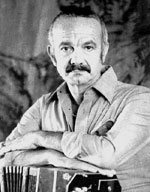The son of Italian immigrants to the Argentinian seaport Mar del Plata, when Piazzolla was three years old his family relocated to New York, where his formative years were inspired by not only the jazz clubs of Harlem (Duke Ellington, etc.) but also a Hungarian neighbour Bela Wilde, who had studied piano with Rachmaninov. The teenager soon worked out how to arrange and play Bach on the bandoneon (a square-built accordion that usually has two reed banks, with thirty-eight buttons for the high and medium registers, and thirty-three for the lower register). The family returned to Argentina in 1937, eventually settling in Buenos Aires, where the young bandoneon prodigy played with the
orquesta típica of Aníbal Troilo (1914-1975) until 1944.
Encouraged by the pianist Rubinstein, Piazzolla studied with Alberto Ginastera, and formed the Orquesta del ’46 to play his own compositions. In 1954 he won a scholarship to study for one year in Paris with Nadia Boulanger, who, upon hearing her pupil play a tango on the bandoneon, encouraged him to embrace his true artistic identity rather than pretend to be someone else. Upon returning to Buenos Aires, his experiences and interests in fugue, chromaticism, dissonance, jazz, popular music culture, contemporary classical composition and traditional Argentinian music fused together to create nuevo tango (‘new tango’). Piazzolla reminisced:
I had two great teachers: Nadia Boulanger and Alberto Ginastera. The third I found in a cold room in a boarding house, in the cabarets in the 1940s, in the cafes with balconies and orchestras, in the people of yesterday and today, in the sound of the streets. That third is called Buenos Aires: it taught me the secrets of tango.
from notes by David Vickers © 2022
Fils d’immigrants italiens établis dans le port maritime argentin de Mar del Plata, Piazzolla avait trois ans lorsque sa famille déménagea à New York, où ses années de formation furent inspirées non seulement par les clubs de jazz de Harlem (Duke Ellington, etc.), mais encore par le voisin hongrois Bela Wilde qui avait étudié le piano avec Rachmaninov. L’adolescent se débrouilla vite pour arranger et jouer Bach au bandonéon (un accordéon de forme carrée muni généralement de deux boîtes d’anches, avec trente-huit boutons pour les registres aigu et médian, et trente-trois pour le registre grave). La famille retourna en Argentine en 1937 et finit par s’installer à Buenos Aires, où le jeune prodige du bandonéon joua avec l’
orquesta típica d’Aníbal Troilo (1914-1975) jusqu’en 1944.
Encouragé par le pianiste Rubinstein, Piazzolla étudia avec Alberto Ginastera, et forma l’Orquesta del ’46 pour jouer ses propres compositions. En 1954, il obtint une bourse pour étudier pendant un an à Paris avec Nadia Boulanger. En entendant son élève jouer un tango au bandonéon, elle l’incita à assumer sa véritable identité artistique au lieu de chercher à être quelqu’un d’autre. De retour à Buenos Aires, ses expériences et intérêts pour la fugue, le chromatisme, la dissonance, le jazz, la culture musicale populaire, la composition classique contemporaine et la musique argentine traditionnelle fusionnèrent pour créer le nuevo tango («nouveau tango»), ce que Piazzolla évoqua dans ses souvenirs:
J’ai eu deux grands professeurs: Nadia Boulanger et Alberto Ginastera. Le troisième, je l’ai trouvé dans une pièce froide d’une pension, dans les cabarets des années 1940, dans les cafés dotés de balcon et d’orchestres, chez les gens d’hier et d’aujourd’hui, dans le son des rues. Ce troisième s’appelle Buenos Aires: il m’a appris les secrets du tango.
extrait des notes rédigées par David Vickers © 2022
Français: Marie-Stella Pâris
Als Piazzolla, Sohn italienischer Einwanderer und gebürtig aus der argentinischen Hafenstadt Mar del Plata, drei Jahre alt war, zog seine Familie nach New York. Geprägt wurde er nicht nur von den Jazzclubs in Harlem (Duke Ellington, etc.), sondern auch von seinem ungarischen Nachbarn Bela Wilde, der bei Rachmaninow Klavier studiert hatte. Der junge Bandoneonspieler lernte bald, die Musik Bachs für sein Instrument zu bearbeiten und sie darauf zu spielen (das Bandoneon ist ein Akkordeon mit quadratischem Querschnitt und zwei Chören und besitzt 38 Knöpfe für Mittel- und hohe Lage sowie 33 für die tiefe Lage). 1937 kehrte die Familie nach Argentinien zurück und ließ sich schließlich in Buenos Aires nieder. Hier spielte das Bandoneon-Wunderkind bis 1944 im
orquesta típica von Aníbal Troilo (1914-1975).
Auf Anregung von Artur Rubinstein studierte Piazzolla Komposition bei Alberto Ginastera und gründete sein eigenes Orquesta del ’46, das seine Kompositionen aufführte. 1954 bekam er ein Stipendium für ein einjähriges Kompositionsstudium in Paris bei Nadia Boulanger. Als diese hörte, wie ihr Schüler auf dem Bandoneon Tango spielte, ermutigte sie ihn dazu, seiner künstlerischen Bestimmung zu folgen, statt sich zu verstellen. Nach seiner Rückkehr nach Buenos Aires führte er sein Wissen und Interesse an Fugensatz, Chromatik, Dissonanz, Jazz, Volksmusik, moderner klassischer Kompositionsweise und der argentinischen Musiktradition zusammen im nuevo tango (dem „neuen Tango“). Piazzolla erninnerte sich:
Ich hatte zwei wunderbare Lehrer: Nadia Boulanger und Alberto Ginastera. Der dritte waren ein kaltes Pensionszimmer, die Cabarets der Vierzigerjahre, die Cafés mit ihren Galerien und Kapellen, die Menschen von damals und von heute, der Straßenlärm. Der Name dieses dritten Lehrers: Buenos Aires. Es lehrte mich die Geheimnisse des Tangos.
aus dem Begleittext von David Vickers © 2022
Deutsch: Friedrich Sprondel






